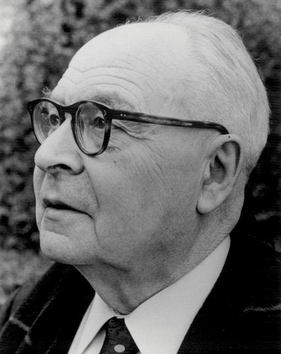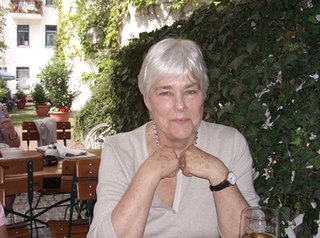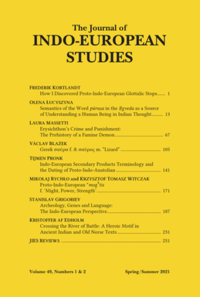The Aryan race is an obsolete historical race concept that emerged in the late-19th century to describe people who descend from the Proto-Indo-Europeans as a racial grouping. The terminology derives from the historical usage of Aryan, used by modern Indo-Iranians as an epithet of "noble". Anthropological, historical, and archaeological evidence does not support the validity of this concept.

Marija Gimbutas was a Lithuanian archaeologist and anthropologist known for her research into the Neolithic and Bronze Age cultures of "Old Europe" and for her Kurgan hypothesis, which located the Proto-Indo-European homeland in the Pontic Steppe.
Lakanica is type of supernatural being from traditional Polish folklore who is a spirit of the fields or meadows. These are reputed to be shy and elusive creatures who can appear in human female form.

Georges Edmond Raoul Dumézil was a French philologist, linguist, and religious studies scholar who specialized in comparative linguistics and mythology. He was a professor at Istanbul University, École pratique des hautes études and the Collège de France, and a member of the Académie Française. Dumézil is well known for his formulation of the trifunctional hypothesis on Proto-Indo-European mythology and society. His research has had a major influence on the fields of comparative mythology and Indo-European studies.
Old Europe is a term coined by the Lithuanian archaeologist Marija Gimbutas to describe what she perceived as a relatively homogeneous pre-Indo-European Neolithic and Copper Age culture or civilisation in Southeast Europe, centred in the Lower Danube Valley. Old Europe is also referred to in some literature as the Danube civilisation.

Indo-European studies is a field of linguistics and an interdisciplinary field of study dealing with Indo-European languages, both current and extinct. The goal of those engaged in these studies is to amass information about the hypothetical proto-language from which all of these languages are descended, a language dubbed Proto-Indo-European (PIE), and its speakers, the Proto-Indo-Europeans, including their society and Proto-Indo-European mythology. The studies cover where the language originated and how it spread. This article also lists Indo-European scholars, centres, journals and book series.
Comparative linguistics is a branch of historical linguistics that is concerned with comparing languages to establish their historical relatedness.

The Kurgan hypothesis is the most widely accepted proposal to identify the Proto-Indo-European homeland from which the Indo-European languages spread out throughout Europe and parts of Asia. It postulates that the people of a Kurgan culture in the Pontic steppe north of the Black Sea were the most likely speakers of the Proto-Indo-European language (PIE). The term is derived from the Turkic word kurgan (курга́н), meaning tumulus or burial mound.
The Journal of Historical Review was a non-peer reviewed, pseudoacademic, neo-Nazi periodical focused on promoting Holocaust denial. It was published by the Institute for Historical Review (IHR), based in Torrance, California. It ran quarterly from 1980 until 1992, and then bimonthly from 1993 until publication ceased in 2002. A supplement, IHR Newsletter, was published alongside the journal.
James Patrick Mallory is an American archaeologist and Indo-Europeanist. Mallory is an emeritus professor at Queen's University, Belfast; a member of the Royal Irish Academy, and the former editor of the Journal of Indo-European Studies and Emania: Bulletin of the Navan Research Group (Belfast).
In historical linguistics, Italo-Celtic is a hypothetical grouping of the Italic and Celtic branches of the Indo-European language family on the basis of features shared by these two branches and no others. There is controversy about the causes of these similarities. They are usually considered to be innovations, likely to have developed after the breakup of the Proto-Indo-European language. It is also possible that some of these are not innovations, but shared conservative features, i.e. original Indo-European language features which have disappeared in all other language groups. What is commonly accepted is that the shared features may usefully be thought of as Italo-Celtic forms, as they are certainly shared by the two families and are almost certainly not coincidental.

Winfred Philip Lehmann was an American linguist who specialized in historical, Germanic, and Indo-European linguistics. He was for many years a professor and head of departments for linguistics at the University of Texas at Austin, and served as president of both the Linguistic Society of America and the Modern Language Association. Lehmann was also a pioneer in machine translation. He lectured a large number of future scholars at Austin, and was the author of several influential works on linguistics.
The Groupement de Recherche et d'Études pour la Civilisation Européenne, better known as GRECE, is a French ethnonationalist think tank founded in 1968 to promote the ideas of the Nouvelle Droite. GRECE founding member Alain de Benoist has been described as its leader and "most authoritative spokesman". Prominent former members include Guillaume Faye and Jean-Yves Le Gallou.

Edgar Ghislain Charles Polomé was a Belgian-American philologist and religious studies scholar. He specialized in Germanic and Indo-European studies and was active at the University of Texas at Austin for much of his career.
Jaan Puhvel is an Estonian comparative linguist and comparative mythologist who specializes in Indo-European studies.

Due partly to the fact that this took place before the written record of this region began, there have been a number of theories presented over the years to fill the gap of knowledge about how and why the end of the Cucuteni–Trypillia culture happened. These theories include invasions from various groups of people, a gradual cultural shift as more advanced societies settled in their region, and environmental collapse.

Albert Richard Diebold Jr. was an American linguistic anthropologist who was Professor of Anthropology at the University of Arizona. He specialized in Indo-European studies.
Raimo Aulis Anttila was a Finnish linguist and professor of Indo-European Linguistics at the University of California, Los Angeles.

Carol F. Justus was an American linguist who specialized in Indo-European linguistics.

Linguistic Semantics: An introduction is a 1995 book by Sir John Lyons designed as an introductory text for the study of semantics within college-level linguistics.









